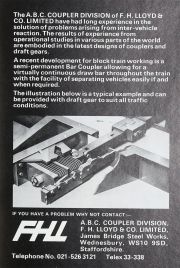F. H. Lloyd and Co











Steel Founders and Manufacturers, of James Bridge Steel Foundry nr Wednesbury
1879 Company established after the closure of Darlaston Iron and Steel Co, Francis Henry Lloyd bought a disused timber yard at James Bridge, and established a small foundry which eventually became F. H. Lloyd's James Bridge Steel Works.
1885 Partnership change. '... the Partnership subsisting between us the undersigned, Francis Henry Lloyd and Harold Hasluck, formerly carrying on business as Manufacturers of Steel Castings, Tubular Coils, and other Articles, at James's Bridge, near Wednesbury, in the county of Stafford, under the style of F. H. Lloyd and Company, has been dissolved as from the 31st day of December last; and that the said business will, as from that day, be carried on by the undersigned, Francis Henry Lloyd alone, and on his own account, at the same place, and under the same style as heretofore...'[1]
1888 Incorporated as a limited company.
1913 Advert for steel castings and machine moulded wheels. [2]
1914 Steel founders. Speciality: steel castings. Employees 350. [3]
1937 Another record year's output for castings[4].
WWII Made turrets for tanks, bomb casings, and many other castings[5].
1946 Plans for modernization of the Darlaston works as well as continued operation of the foundry at Burton which was being equipped for making castings for railway use[6].
1952 Two subsidiary companies:
- Lloyds (Burton) Ltd (which supplied automotive and defence markets) and
- Parker Foundry (1929) Ltd at Derby[7] [8].
1963 Death of Cyril Lloyd, age 86, who had had a long career with N. Hingley and Sons, and was a descendant of the Lloyds banking family, had contributed his experience in later life to F. H. Lloyd and Co which was run by relatives[9].
1965 Subsidiaries included E. C. and J. Keay, constructional engineers, Mechanical and Electrical Engineering Co of Walsall[10]
1966 Acquired the group of companies owned by N. Hingley and Sons[11] [12]
1967 Acquired Summerson's Foundries which was continued as Lloyds (Darlington) Ltd, providing the group with steel foundries in the North East development area in addition to those in the South Wales development area. Disposed of Wye Foundry Co; ceased brick making at Halesowen Brick and Tile Co. Merged Wright's Forge and Engineering Co and N. Hingley and Sons (Netherton), which were making losses, to specialise in forged rings from high alloy steels [13]
c.1970 Brochure "Masters of Steel" described products and facilities, focusing on James Bridge Steel Works, but also including information on the Cardiff Foundry and Lloyds Steel Fabrications (Tipton). Also listed are the products of other FHL Group members, Parker Foundry (Derby), M. and W. Grazebrook (Dudley), John Bagnall and Sons, Wednesbury, Wright Hingley, Netherton, Lloyds (Burton) Ltd, and Brown, Lenox and Co (Pontypridd).
1970 F. H. Lloyd Holdings was created to hold Hingley's and F. H. Lloyd's.
1970 Acquired quarry plant machinery business from the Armstrong Whitworth subsidiary of Davy-Ashmore[14]. Acquired the Old Park Engineering subsidiary of Tube Investments[15]
1972 Announced plans with Cooper Industries to establish a steel "mini-mill" to make billets in West Bromwich[16]. Later information states that it was in Peartree Lane, Dudley and named Lloyd Cooper.[17]
1974 Cast and machined the steel cable bands for the Humber road bridge.[18]
1974 John Mason resigns ad MD from Lloyds (Darlington) to take up the position of works director of F. H. Lloyd and Co.[19]
1976 Lloyds (Darlington) foundry closed[20]
1980s: F H Lloyd, at one time the largest steel foundry business in Europe, fell into a severe decline resulting in the closure of the Wednesbury foundry in 1982 and the Parker foundry at Derby in 1987.
1981 The Cardiff foundry was closed[21]
1987 Lloyds (Burton) was the last remaining steel foundry still operating of the three foundries which were once part of the F H Lloyd Group.
1987 Triplex Lloyd formed by merger with Triplex Foundries Group[22]
By 1989 although Lloyds (Burton) was trading profitably it was no longer relevant to the Triplex Lloyd strategy and was sold to William Cook.
See Also
Sources of Information
- ↑ The London Gazette Publication date:3 April 1885 Issue:25457 Page:1551
- ↑ Mechanical World Year Book 1913. Published by Emmott and Co of Manchester. Advert p58
- ↑ 1914 Whitakers Red Book
- ↑ The Times, Sep 24, 1937
- ↑ The Times, Jul 02, 1945
- ↑ The Times Aug 09, 1946
- ↑ The Times, Jul 21, 1952
- ↑ The Times Jul 20, 1956
- ↑ The Times, Feb 26, 1963
- ↑ The Times, Jul 19, 1965
- ↑ National Archives [1]
- ↑ The Times, Jul 09, 1966
- ↑ The Times July 4, 1968
- ↑ The Times Feb 07, 1970
- ↑ The Times, Apr 24, 1970
- ↑ The Times, Jun 10, 1972
- ↑ 20200713-DA
- ↑ The Engineer 1974/06/06
- ↑ Birmingham Daily Post - Wednesday 28 August 1974
- ↑ Competition Commission report on William Cook, 1990
- ↑ Competition Commission report on William Cook, 1990
- ↑ The Times, November 24, 1987
- Competition Commission report 1990

